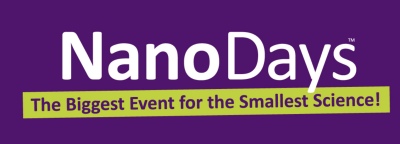
The NISE Network is no longer creating and distributing new NanoDays kits; the last kit we created was in 2015. We encourage you to hold NanoDays events and use NanoDays materials year-round. You can download digital kit materials here: www.nisenet.org/nanodays
How to participate in NanoDays
Being part of NanoDays is easy: all you need to do is host a day or a week of activities on the theme of nanoscale science, engineering, and technology during NanoDays, the last week in March and first week in April. The NISE Network has developed a variety of resources to help you, including NanoDays kits and other products on the nisenet.org website. Every year, over 250 NanoDays events are held across the country, including hands-on activities and demos, speaker events, theater presentations, art shows, lab tours, lectures, deliberative forums, and science cafes. Through NanoDays, the NISE Network reaches audiences across a diverse geographic distribution as well as people with disabilities and under-represented audiences in STEM (science, technology, engineering, and math).
What can you do for NanoDays?
Many NanoDays celebrations combine simple hands-on activities with events exploring current research. One popular activity involves visitors working together to build a giant balloon model of a carbon nanotube. Other NanoDays activities demonstrate different, unexpected properties of materials at the nanoscale: sand that won’t get wet even under water, water that won’t spill from a teacup, and a liquid that acts like a magnetic solid. Some NanoDays participants host science cafés or public forums with discussions about the risks and benefits of particular applications of nanotechnology. Some participating universities host public tours of their laboratories that work with nanoscale science and technology. For lots of ideas about what you could do for NanoDays, browse all the programs and activities on the website.
Kits and Eligibility
Each year, between 2008-2015 the NISE Net developed and distributed kits that contained high-quality activities designed to introduce the public to basic concepts of nanoscale science, engineering, and technology. NanoDays kits contain everything needed for immediate use, including all materials and documentation. Kits distributed for NanoDays 2008-2015 have included slightly different inventories of activities, based on the same ready-to-use model. Continuing collaborators and new partners alike can look forward to new sets of activities in future kits. There are two kinds of NanoDays kits: the physical kit and the digital kit. Both kits provide the same information about hands-on activities, and include guides and tips to help you stage your NanoDays events. The physical kit contains all materials and supplies for each activity and includes physical signage; digital kits include downloadable guides and printable graphic files.
Physical Kit Eligibility:
- These kits are designed for informal science educational institutions (such as museums and research center outreach programs) within the United States.
- We are not able to send physical kits to K-12 schools.
- We are not able to send kits to locations outside the United States.
Digital Kit Eligibility:
- Free online download is available to anyone who registers on nisenet.org.
- The digital kit is designed particularly for international locations outside the United States, K-12 educators, libraries, and other educational organizations. Most of the activities use inexpensive, readily-available supplies.
Common Questions:
NanoDays provides a great opportunity for scientists and museum educators to collaborate, creating unique learning experiences and engaging people of all ages. No matter if your event takes place during our week or a time that better meets your needs, or whether you have a physical kit or have downloaded digital resources, you can be a part of NanoDays!
- I do not live in the United States, can I get a physical NanoDays kit?
Unfortunately, we are not able to send physical NanoDays kits outside of the United States. Physical kits are designed for informal science educational institutions (such as museums and research center outreach programs) within the United States. - I am a K-12 teacher in the United States, can I get a physical NanoDays kit for my school?
Unfortunately, we are not able to send physical NanoDays kits to K-12 schools. Physical kits are designed for informal science educational institutions (such as museums and research center outreach programs) within the United States. We encourage you to download a digital kit for use in your classroom or school event. There are also many other K-12 lesson plans and other educational products available on this website. - You do not need a physical NanoDays kit to hold a NanoDays event! Free online download of the Digital NanoDays kit is available to all nisenet.org visitors, and is intended particularly for locations outside the United States, K-12 educators, libraries, and other educational organizations. The digital kit includes a planning guide, marketing materials, activity signs and guides, supply lists, media, training videos, and much more to use during your NanoDays event. Many of the activities use inexpensive, readily available supplies.
Application and Reporting for 2015 kits
A total of 250 physical kits will be distributed on an application basis to informal science educators and research education specialists within the United States who deliver these programs and activities to public audiences. Kit recipients are expected to provide feedback about their NanoDays events using an online report. Kit recipients also receive support and advice from regional coordinators that are located at key institutions, or hubs, across the country.
Timeline for 2015 kits
The online application for the physical NanoDays kit is open each year from October-December 1. Delivery of the physical kits takes place in the first week of January. A digital version of the kit becomes available for download in mid January.
